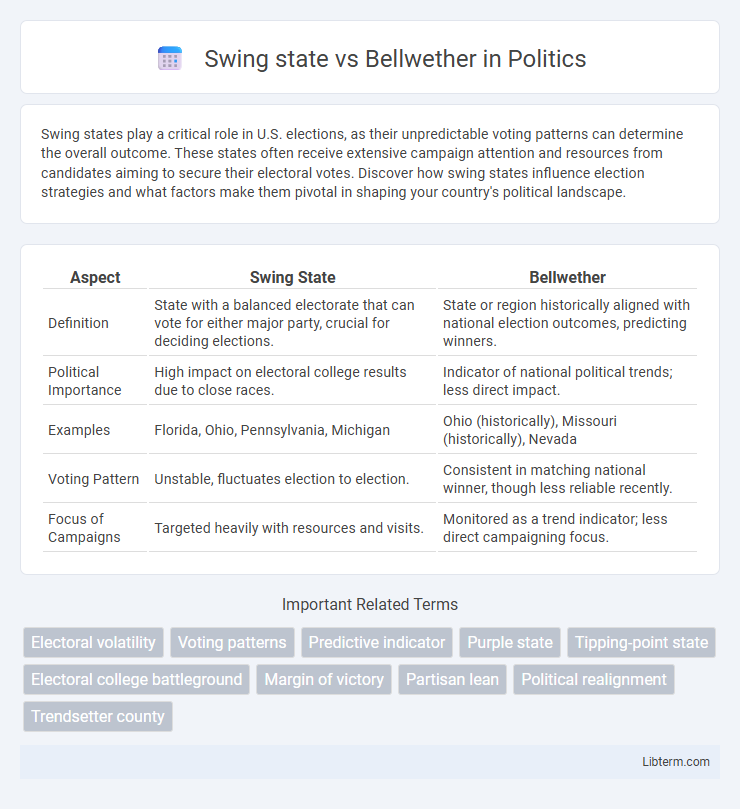Swing states play a critical role in U.S. elections, as their unpredictable voting patterns can determine the overall outcome. These states often receive extensive campaign attention and resources from candidates aiming to secure their electoral votes. Discover how swing states influence election strategies and what factors make them pivotal in shaping your country's political landscape.
Table of Comparison
| Aspect | Swing State | Bellwether |
|---|---|---|
| Definition | State with a balanced electorate that can vote for either major party, crucial for deciding elections. | State or region historically aligned with national election outcomes, predicting winners. |
| Political Importance | High impact on electoral college results due to close races. | Indicator of national political trends; less direct impact. |
| Examples | Florida, Ohio, Pennsylvania, Michigan | Ohio (historically), Missouri (historically), Nevada |
| Voting Pattern | Unstable, fluctuates election to election. | Consistent in matching national winner, though less reliable recently. |
| Focus of Campaigns | Targeted heavily with resources and visits. | Monitored as a trend indicator; less direct campaigning focus. |
Introduction to Swing States and Bellwethers
Swing states are key battlegrounds in U.S. elections where voter preferences closely divide between major political parties, making them critical for determining electoral outcomes. Bellwether states historically align with national election results, serving as predictive indicators of the overall winner. Understanding the distinction helps analysts forecast election trends and strategize campaign efforts effectively.
Defining Swing States
Swing states, also known as battleground states, are U.S. states where both major political parties have similar levels of support among voters, making election outcomes highly uncertain and competitive. These states receive significant attention during presidential campaigns due to their potential to swing the overall electoral vote either way. Defining swing states involves analyzing voter registration data, historical election results, and current polling trends to identify regions with fluctuating party dominance and crucial electoral influence.
Understanding Bellwether Regions
Bellwether regions are areas whose election results historically predict or reflect the overall outcome of a national election, making them critical for analyzing voting trends. Unlike swing states, which can change party preference and are highly contested, bellwether regions consistently align with the eventual winner, serving as reliable indicators of broader political sentiment. Understanding bellwether regions helps political analysts and strategists anticipate election results by closely monitoring demographic, economic, and social factors influencing voter behavior within these key geographic areas.
Historical Significance of Swing States
Swing states such as Ohio, Florida, and Pennsylvania have historically played pivotal roles in determining the outcome of U.S. presidential elections due to their unpredictable voting patterns and balanced party support. These states attract intense campaign attention and substantial electoral resources because their electoral votes can decisively influence the final result. Unlike bellwether states, which consistently predict election winners, swing states are characterized by fluctuating political affiliations that reflect broader national divides.
Bellwether Counties and Their Track Record
Bellwether counties hold a unique position in U.S. elections due to their consistent ability to predict the winner of presidential races, accurately reflecting national voting trends. Examples like Vigo County in Indiana and Valencia County in New Mexico have matched the overall election outcome in nearly every presidential election for decades. Their track record serves as a valuable indicator for political analysts and campaign strategists seeking insights into broader electoral dynamics.
Key Differences Between Swing States and Bellwethers
Swing states are crucial battlegrounds in U.S. elections where the vote can swing to either major party, often influenced by current political dynamics and campaign efforts. Bellwether states consistently predict the overall election outcome by aligning with the winning presidential candidate over multiple election cycles. The key difference lies in swing states' electoral volatility versus bellwether states' historical accuracy in forecasting national results.
Notable Examples: Swing States in Recent Elections
Notable swing states in recent U.S. elections include Florida, Pennsylvania, and Wisconsin, which have consistently played pivotal roles in determining presidential outcomes. Florida's diverse electorate and status as a major electoral vote holder make it a critical battleground, while Pennsylvania and Wisconsin have shifted between parties, reflecting broader national trends. These swing states often receive intense campaign attention due to their unpredictable voter behavior and significant impact on the Electoral College.
Famous Bellwether Counties and States
Famous bellwether counties such as Vigo County in Indiana and Clinton County in Ohio have consistently predicted the outcome of U.S. presidential elections, making them key indicators of national voting trends. Bellwether states like Missouri and Nevada have historically aligned with the winning presidential candidate, reflecting their diverse demographics and political balance. These regions contrast with swing states, which are highly contested but do not always match the overall election result, emphasizing the unique predictive power of bellwether areas in electoral analysis.
Impacts on Political Campaign Strategies
Swing states like Florida and Ohio receive disproportionate attention in political campaigns due to their unpredictable voting patterns, prompting candidates to allocate more resources and tailor messages to diverse voter blocs. Bellwether states, identified by their historical alignment with national election outcomes, influence campaign strategies less in resource allocation but serve as critical testing grounds for policy messaging and voter engagement tactics. Understanding the distinctions between these states enables campaigns to optimize targeting strategies, maximize electoral impact, and efficiently mobilize voter turnout in pivotal regions.
Future Trends: The Evolving Landscape of Swing States and Bellwethers
Swing states and bellwethers are crucial indicators in U.S. elections, with swing states often determining outcomes through their unpredictable voter bases. Emerging demographic shifts, such as increasing urbanization and minority populations, are reshaping traditional swing states like Arizona and Georgia, making their future electoral roles more dynamic. Bellwether counties, historically aligned with national results, face evolving political landscapes that may diminish their predictive reliability in upcoming election cycles.
Swing state Infographic

 libterm.com
libterm.com